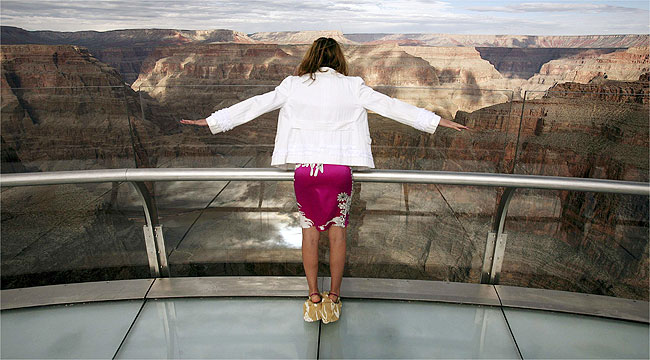Here's an update on the Grand Canyon Skywalk, which I've covered since it was an idea on the drawing board several years ago.
World falling for Grand Canyon Skywalk[I]f you'd totally bought into everything your intellect suggested, you might not be here at all. You'd have saved the $73 ($43.05 for the entrance fee, $29.95 for the Grand Canyon Skywalk adult ticket), you'd have avoided subjecting your vehicle to the 70-mile, 90-minute drive out from Kingman, Ariz., most of the last 12 miles on dusty-graveled or paved-but-potholed roads. Instead, you'd be back in Las Vegas winning big at the roulette table. (Or not.)And:
In its fourth year, the Skywalk has become a regular attraction not just for Chinese, but for Germans, Italians, Americans from around the country. For someone visiting Las Vegas or Laughlin, Nev., it's closer than Grand Canyon National Park, and the view is nearly as spectacular, although somewhat limited in scope.
Nobody I talk to is disappointed in the experience, although I would warn not to come here with huge expectations. And I haven't even written about environmental implications, impacts to the tribal members--some of whom consider this place, Eagle Point, as sacred ground.
It's a $31 million gimmick, and judging by the crowds, at least from a financial standpoint, so far it appears to be a worthy gamble.Comment: I wouldn't have guessed the Skywalk would be a success. A four-hour drive from Las Vegas...12 miles on dirt roads...$73 for a 15-minute experience...and no cameras. I don't think I'd go to Mt. Rushmore or the Eiffel Tower under those conditions. But clearly many people are eager, if not desperate, for a sight of the Grand Canyon.
A
previous report said visitors
were going away disappointed. Have things changed, or is this reporter merely putting a better spin on things? I don't know.
For an impressive video of the location, go to the official
Grand Canyon Skywalk site. For more on the subject, see
Skywalk Brings Honor to Hualapai? and
Grand Canyon vs. Grand Canyon West.
Below: "Connie Smith, with the Grand Canyon Skywalk in the background, wears a dress that tells the story of how her band of Hualapai Indians were forced off their land but later returned." (John Peel/Herald)




















